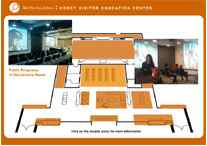
OK, OK, OK, I missed to report the last two lunchs, it is completely my fault, just to let you know they were about the Photography departement and the Educational one (where I'm actually interning!!!).
To briefly summarize, when I visited the PHOTOGRAPHY DEPARTEMENT I've been brought with the other interns, first in the Museum gallery, where we have been provided of information mainly about curatorial choices in order either to satisfy visitors requests (everybody expects to see at least a Stiegliz picture or a Man ray one!!!), either to povoke and provide a critical perspective about what artistic photography is.
The next step was visiting the BEHIND THE SCENES!!!
Upcoming photos, emerging artists, huge photos,archives and laboriatories..
here the link to the photography collection on the website (more than 2500 phtographies!!!)
 I think you all already know a lot about the educational departement and its ongoing activities, like Making Sense of Modern Art (MSOMA), created with Pachiderm, an open-source flash Content management system..
I think you all already know a lot about the educational departement and its ongoing activities, like Making Sense of Modern Art (MSOMA), created with Pachiderm, an open-source flash Content management system..
But probably it is difficult to understand how the phisical presence of the "Koret visitors educational center", has deeply influenced the identity of the museum: in fact, beeing in the "heart" of the museum, it has given a great input in the definition of the role a museum should have: not only a place where works of art are stored and displayed, but a place where people can really Make sense and understand what works want to communicate, without banalizing concepts and providing all the necessary tools for the interpretation and enjoinment of subjects that often people consider as mysterious and understandable only for "experts".. catalogues, confortable seats, video screenings, interactive kiosk, many computers with additional contents of MSOMA, kids areas and rooms for lectures.. PLUS a frinedly staff always available for any necessity. Check out the interactive feature to discover more.
But now is time to talk about the real topic of this post; The EXHIBITION DEPARTEMENT: when you go to wathever museum and visit some huge exhibition about some artist, it seems that every piece has its natural collocation in the area, like if the museum has been designed to host that exhibition and stop; well, is not like that: many of the walls present in an exhibition are removable, it is an hard work to decide where and how a piece has to be, it is a decison that involves more than one departement.. There mainly two phases in the preparation of an exhibition:
- The "design" phase
- The hard work!!!
The design phase: there are two kinds of "tools" used for the set up: on one side there are computer, with softwares like archicad difning the virtual placement of each piece. Actually a 3D software that allows to explore a virtual reconstruction of the museum is beiing tested. On the other side the is an "old-style stuff": a room containing a scale model of the museum, with small reproductions of every single piece (even the ones of past exhibitions are conserved, never knows..), and little walls that can be connected and disconnected: here curators meet and set up the exhibition according to their necessities, from interpretative and philological , to security and accessibility ones. But this is the "theoretical" part.
The hard work
Once everything has been decided, a team of workers begins to disconnect and re-connect pieces of the museum, working in physical contact with the artist, rather than relying on written indications by the artist itself. And now a curiosity: in the museum, behind one huge walls, there is an enormous elevator, with which pieces and walls are carryed from one stair to another!!!
The work of this departement is really hard and linked to very narrow deadlines, implies a great part of "manual" work; think for example at the current exhibition of Matthew Barney, in which are present huge works in weird locations (i was impressed seeing the hands of the exhibition departement curator..), but I think brings a lot of satisfactions...
I apologize for the usual "maccheronic" english, but I hope this report can be useful for you all, as it has been for me.
Amoenus.





